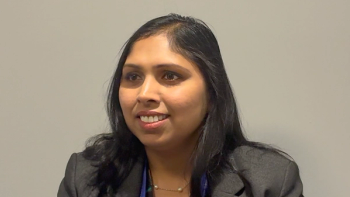
Vorinostat achieves promising preliminary responses in indolent lymphomas
Vorinostat (Zolinza) showed encouraging single-agent activity and was well tolerated over long durations of therapy in patients with two forms of indolent lymphoma, relapsed/refractory follicular and marginal zone lymphoma, according to results of a phase II study
SAN FRANCISCO -- Vorinostat (Zolinza) showed encouraging single-agent activity and was well tolerated over long durations of therapy in patients with two forms of indolent lymphoma, relapsed/refractory follicular and marginal zone lymphoma, according to results of a phase II study.
Mark Kirschbaum, MD, from the division of hematology, City of Hope National Medical Center in Duarte, Calif., led the study conducted by the California Cancer Consortium. The study received no industry funding, although three of Dr. Kirschbaum's eight co-authors disclosed participation on the Merck speakers bureau.
Although patients with low-grade lymphoma tend to respond to initial chemotherapy, lymphoma recurs in about 50% of them after five years, the authors indicated. With each new successive line of therapy, disease-free intervals become shorter. New, more effective and less toxic agents are needed, particularly for this predominantly older group of patients, Dr. Kirschbaum wrote (abstract 1564).
Vorinostat, an oral histone deacetylase inhibitor, is approved by the FDA for treatment of cutaneous T-cell lymphoma in patients with progressive, persistent, or recurrent disease on two prior therapies. The drug is also being studied in other hematologic malignancies, including indolent non-Hodgkin's lymphoma.
The study enrolled 35 patients to receive Vorinostat 200 mg/b.i.d. for 14 consecutive days on a 21-day cycle until disease progression or unacceptable toxicity. Histology was follicular lymphoma (n = 20 patients), mantle cell lymphoma (n = eight patients), and marginal zone lymphoma (n = seven patients).
Patients were allowed to receive up to four prior chemotherapy regimens, as well as prior transplant. Ten patients underwent prior radiotherapy and seven had previous transplant. Median age was 65 (range, 32 to 79 years). CT scanning and/or FDG-PET were performed every three cycles. Marrow biopsies were obtained every three cycles for patients with marrow involvement at study entry.
Treatment was well tolerated, with these grade 3-4 toxicities potentially related to the drug: thrombocytopenia, neutropenia, anemia, diarrhea, anorexia, myalgia, hypokalemia, hypophosphatemia, thrombus, and fatigue. Progressive disease was observed in 18 patients, who were taken off the study.
Three of the 35 patients discontinued the study due to toxicities (fatigue and diarrhea after 10 cycles, diarrhea and dizziness after five cycles, deep vein thrombosis after five cycles). An additional patient stopped therapy due to intercurrent illness, and one discontinued treatment for alternate therapy.
According to Cheson criteria for response, six complete remissions (CR) and four partial remissions (PR) were identified for an overall response rate of 29% (10/35). No CR or PR was seen in patients with mantle cell lymphoma. An additional 11 patients overall had stable disease for six months, including patients with mantle cell lymphoma. One patient with stable disease for six years achieved CR after cycle 36.
Two patients with PR as the best response subsequently progressed and the other two remained on therapy at the time results were presented. One CR was achieved after two years of stable disease on therapy.
At a median follow-up of 12 months, median progression-free survival was seven months for 35 evaluable patients. Five of these patients have been progression-free for more than 18 months, and 11 patients remain on therapy.
Based on the encouraging single-agent activity of Vorinostat in indolent lymphomas, combination studies have been initiated with agents such as rituximab (Rituxan), according to the authors.
Newsletter
Stay up to date on recent advances in the multidisciplinary approach to cancer.





















































































